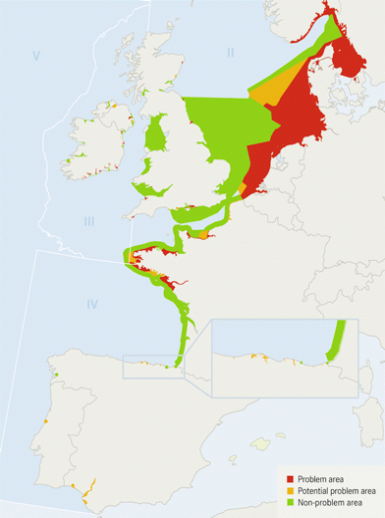Governance
The concern about eutrophication in European waters led to several European Directives that have explicit requirements to assess eutrophication in order to implement measures to protect ecosystems and coastal water quality. These are the Nitrates Directive (1991/676/EC), the Urban Waste Water Treatment Directive (1991/271/EC) and most recently the Marine Strategy Framework Directive (MSFD, 2008/56/EC; see here and here), which includes eutrophication as one of the 11 quality descriptors of environmental status in European marine waters.

Left: EU flag, right: European Commission, Brussels
In addition there are international conventions that have developed methodologies specifically to assess eutrophication. Of particular interest for the NEA is the OSPAR Comprehensive Procedure to combat eutrophication in the Greater North Sea.

Eutrophication status in the period 2001-2005 (OSPAR, 2008)
Both the MSFD and OSPAR focus on biological quality descriptors/indicators of undesirable eutrophication and eventually the nutrient reduction that needs to be achieved to reach quality targets but none of them explore the feasibility of reaching the required nutrient reduction. As a complement, the Water Framework Directive (WFD, 2000/60/EC, see here and here) is defining legislation for protecting EU waters all along the freshwater-estuary-nearshore coastal waters continuum. Integration of these Directives and convention based on an holistic view of eutrophication mechanisms and causes is clearly needed.
References
OSPAR, 2008. Second OSPAR Integrated Report on the Eutrophication Status of the OSPAR Maritime Area. ISBN 978-1-906840-13-6.

